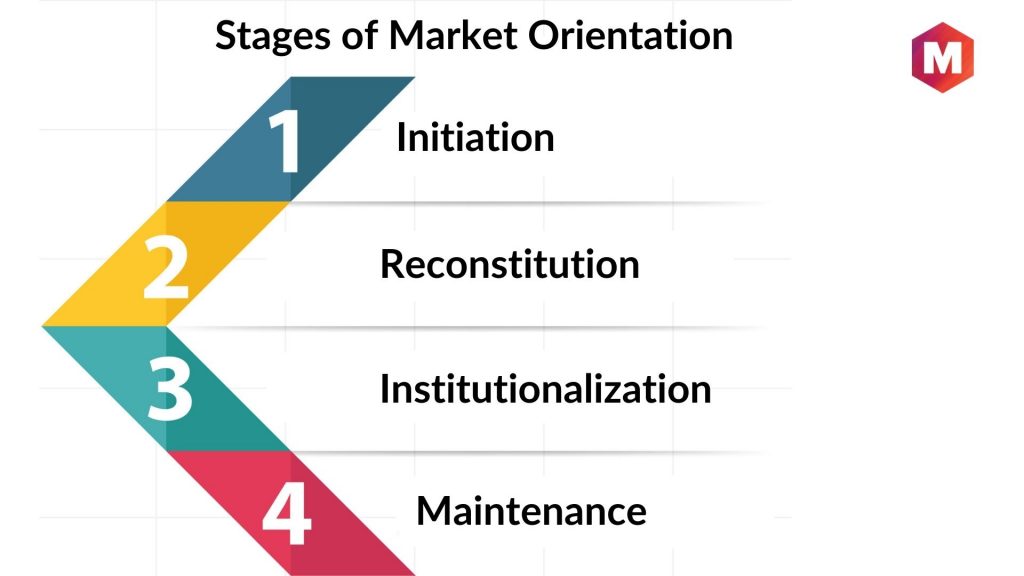Table of Contents
What is Market orientation?
Market orientation is defined as an approach of a business entity that identifies the needs and wants of its target audience or consumers and accordingly shapes its activities and offerings to satisfy these needs. This approach is based on the notion that all decisions taken by a business should be focused on satisfying customer requirements.
An example of market orientation could be seen in a company that offers quality customer services. Such a company would focus on customer retention by providing customers with the best possible experience before, during, and after their purchase. The company should consider customer feedback when deciding how to improve its services and products.
Generally, a market-oriented business entity tends to have strong customer relationships and relies heavily on research and data gathering to identify customer requirements and preferences.
Key Takeaways
- Market orientation is a customer-centered strategy that focuses on meeting the requirements and desires of target consumers through research and feedback.
- It entails adjusting corporate actions and services based on extensive research on client preferences and concerns.
- Companies with a market orientation prioritize good customer service and use feedback to improve continuously.
- Market orientation is part of a more significant notion encompassing sales, product, and societal orientations, but it prioritizes consumer demands over product innovation or sales methods.
- Data analysis and research are critical in a market-oriented strategy for anticipating client requests and adapting products accordingly.
Meaning of Market Orientation
Market orientation is about the marketing teams adopting a customer-centered approach to designing and creating products. It includes detailed research to understand the target consumers’ views, personal preferences, and primary concerns within a specific product category.
Sometimes, business entities use data analysis to reveal trends, new trends and desires of their customers because knowledge is power, and it proves beneficial in anticipating the demands and improvising product specifications to match the desires of their target customers.
Market orientation is one aspect of the broader concept of orientation, i.e., the marketing orientation approach. The other elements include sales orientation, product and marketing orientation approaches, and societal orientation. Sales orientation focuses on sales-driven strategies, product-oriented companies focus on product innovation, and market-oriented companies are customer-oriented. Hence, in a market-oriented approach, the focus is on gathering and responding to customer feedback to provide goods and services that meet their needs.
How does Market Orientation work?
It works by understanding the needs of customers and responding to those needs. It is a customer-centric process, meaning that all elements of an organization’s operations, from product design to customer service, should be aimed at satisfying customer needs.
A market-oriented company ensures that there is a continuous demand for its existing products and services. Adaptability is the key in these competitive times. Instead of convincing customers to try something new, the companies are changing their product portfolio to suit consumer requirements.
Organizations must remain on their toes to achieve desired success in consumer markets. They develop marketing strategies and deploy them via advertisements and promotional campaigns as products consumers need today.
The market orientation principles have put their onus on target customers rather than on convincing sales tactics. They do not want to convince people to buy their products; instead, they are ready to give them what they want.
For example, if a restaurant finds that most of its customers are interested in eating pizza, it will try to create and serve them as per the demands of its customers rather than try to convince them to try a burger.
Stages of Market Orientation
A market-oriented strategy goes through the following stages:
- Initiation: It is the initial stage of orientation, where companies start recognizing and focusing on customer needs and wants. This is achieved by gathering data from market research and customer feedback.
- Reconstitution is the second stage of orientation, where companies use this collected data to modify their products or services. This may include changes in pricing, product design, advertising, etc.
- Institutionalization is the third stage of market orientation, where companies integrate customer orientation into all aspects of their business operations, from internal processes to external communications.
- Maintenance is the last stage of orientation, during which companies ensure customer orientation continues to be a core part of their operations and focus. This includes tracking consumer trends, implementing new strategies, training staff, etc.
Characteristics of Market Orientation
A market-oriented organization emphasizes surveys and research about its market share and its target customers’ needs and wants. They want to know the opinions of their consumers so that they can determine what the customers are looking for in products and services.
Once the market-oriented company is aware of the demands and wishes of its potential customers through feedback, it tries to exceed them by offering the best possible product.
Building anticipation amongst its customers through promotion and marketing campaigns is a simple way to garner customer attention.
Once a customer is hooked, it becomes easier for the business entities to garner considerable sales in the market.
Advantages of Market Orientation
The numerous advantages of market orientation are as follows:
- It is the customers that help the business thrive and grow. The market orientation helps the company attract more customers as the products are in sync with the demands and needs of its customers.
- A customer-centric approach helps to avoid wasted resources, as the company is already aware of the needs and wants of its customers.
- The market orientation approach helps the business entity garner assured profits through credible sales figures.
- The business entities that have adopted market orientation recognize that customers have become the driving force behind strategies and have created specific products that will meet their approval. It has increased customer satisfaction and achieved loyalty.
- The market orientation approach has increased a business entity’s volume and market share.
- Listening to the needs of its customers has helped the brand create innovative products that the target consumer desires.
- There has been an improvement in effectiveness
- The business entities that have followed the concept of market orientation have proved themselves more resilient to change than other companies, as they adapt well to market trends
- The satisfaction and happiness of the customers are reflected in the employees’ smiling faces.
Disadvantages of Market Orientation
The disadvantages of market orientation are as follows:
- Market-oriented companies are more concerned with meeting the desires of their customers than creating new and innovative products. More motivation is needed to gain sight of potential innovative breakthroughs.
- It takes work to create and target campaigns that can meet the demands of all its customers.
- Market research is a costly business and has a direct impact on revenues.
- With product differentiation, it becomes easier to stand its ground in the face of competitive rivals.
- What consumers want is not a fixed thing, as it can change at the drop of a hat. A business entity might need help to keep up with those ever-changing needs and wants.
Pillars of market orientation
The three pillars of market orientation have helped business entities to create competent strategies. Earlier, companies followed traditional product orientation policies but realized the importance of market orientation in changing times.
It is a tough call to make and switch, but the benefits are immense. The new way of thinking has helped management reach new heights. The pillars have been described as
1. Customer focus
Globalization, the advent of branded goods, and awareness via the Internet have resulted in customer empowerment. This has forced several companies to take a long look at their policies and develop a market orientation focused on customers instead of products, growth, and profitability.
When the customer takes center stage, the companies establish a course that helps them to serve a customer what he wants and not what they want to sell. This helps to develop a long-term relationship with the customers, who later become their strategic assets
2. Co-ordinated marketing
Measuring productivity in marketing is a challenge for business entities. It has to break the confines of the typical 4P framework if it wants to establish itself as a customer-centric company.
The business now has to adopt a coordinated marketing infrastructure to meet the actual demands of its customers.
3. Profitability
Business entities are under pressure to demonstrate the financial strength of the company every quarter. The effect is felt on stock prices, which can come down or rise depending on the company’s financial condition.
The framework of market orientation and profitability includes both non-financial and financial measures. This will allow entities to balance long- and short-term profitability and the company’s health.
Market Orientation vs. Other Strategies
In today’s competitive marketplace, establishing a market orientation approach entails putting the requirements and preferences of the consumer first in product creation. This method differs from a product orientation strategy, which focuses on making the consumer recognize the product’s distinctive traits and advantages.
Furthermore, promoting product differentiation is a popular method in a product-oriented approach, which uses distinctive advertising efforts to showcase what distinguishes a company from its competitors.
On the other hand, a sales orientation approach focuses on generating rapid customer action through various promotional activities such as digital advertising, social media engagement, television commercials, live demos, and targeted direct marketing campaigns.
While combining these tactics can contribute to marketing success, businesses frequently favor one or a few methods that are closely aligned with their overall objectives.
Consider Wizzle Coffee, which stresses market orientation by producing tastes based on user feedback, as opposed to SparkTech Electronics, which focuses on product orientation and advertises the revolutionary features of its devices. Meanwhile, Glitzy Cosmetics has a sales-oriented strategy, leveraging Instagram influencers and pop-up stores to promote purchases directly.
Addressing these strategies offers a comprehensive perspective, assisting MBA students in navigating the intricacies of market orientation compared to other strategic techniques used in real-world applications.
Examples of Market Orientation
IKEA
IKEA is a prime example of a market-driven corporation. As it has grown and expanded, it has constantly modified its business philosophy, operations and offers to meet consumers’ expressed requirements and interests.
For example, one of the critical concerns for many urban residents is getting fashionable and space-efficient furniture. IKEA addressed this issue through its space-saving yet attractive designs.
However, some buyers are concerned about assembling furniture. For this purpose, IKEA developed thorough yet straightforward assembly instructions and even provides assembly services for customers who prefer to do it with others.
PepsiCo
PepsiCo is yet another multinational giant renowned for its market orientation. It invests substantially in research to identify new tastes that appeal to consumers, such as mango chili and yogurt soda. However, providing a range of flavors does not address consumers’ growing health concerns. To offset this, PepsiCo broadened its portfolio to include health-conscious brands, including Tropicana, Quaker Oats, and Naked Juice.
These two business examples demonstrate that a thriving market orientation approach entails first understanding the target market’s requirements and concerns and then producing products or services to suit them. Both IKEA and PepsiCo have demonstrated that being responsive to consumer preferences and staying ahead of consumer behavior trends may lead to growth and success.
Other types of marketing orientation
1. Product Orientation
Firms that follow the product orientation principle prioritize the craftsmanship and integrity of their services or goods. Their strategy typically includes using research and development to meet market demands or differentiate themselves from competitors.
By incorporating helpful client feedback and constantly developing their services, these companies aim to increase their long-term worth through unique and compelling products.
2. Production Orientation
In contrast to product-oriented enterprises, production-oriented businesses shift to a larger quantity output model, aiming to meet market demands quickly. Given their mass production strategy, these companies can position themselves attractively in terms of price appeal. The low prices attract more clients, provided that the level of quality remains competitive with comparable products.
3. Societal Orientation
The societal orientation method has gained popularity recently and prioritizes the firm’s societal footprint. Companies under this label promote efforts that benefit the environment, specific societal groups, or local communities. Embracing social responsibility and supporting causes consistent with their consumer value system can significantly improve the company’s brand and image.
4. Sales Orientation
The sales-oriented approach, which focuses on the transactional side, encourages organizations to prioritize sales and inventory turnover. This strategy focuses on increasing earnings while appealing to specific client categories. However, the primary goal is sales-oriented, which some customers may find indifferent or offputting.
Choosing the Marketing Orientation Approach That Best Fits Your Business Model
Market dynamics need organizations to adapt to changing consumer behavior. In 2005, Intel Corp switched from a product-centric to a market-oriented approach, delivering solutions to customer problems such as computer failures.
Amazon’s market-oriented approach is shown by its constant enhancement of services to meet client demands and reservations, such as delivery prices. Amazon Locker is a tool for urban homeowners worried about delivery in their absence.
Coca-Cola introduces new tastes by doing extensive customer research on flavor preferences. It now owns Dasani, Minute Maid, and SmartWater, its flagship brands.
Different approaches vary significantly in efficiency among enterprises. Organizational foundation, culture, and structure should affect marketing orientation choice. With good personnel monitoring and management, an organization’s approach can boost team performance. Traqq lets you track project and personnel activity.
The technology records employees’ working hours, allowing productivity and performance assessments. Traqq’s desktop app counts every minute, even offline, to assure data accuracy. Not only that. Traqq provides GDPR-compliant ethical employee tracking to protect your data. You have complete control over your data and can delete it.
Conclusion
Market orientation is a strategic approach focusing on understanding and addressing client needs, building strong consumer relationships, and using feedback to drive innovation and flexibility. This customer-centric approach, exemplified by prominent organizations such as Amazon and Nike, helps businesses to increase loyalty, innovate successfully, and achieve long-term growth and profitability in a competitive environment.
FAQS
1. What is market orientation?
It occurs when a corporation ensures that everything it does is targeted at satisfying its customers. They listen to what people desire and try to provide it.
2. How does it differ from product orientation?
If a corporation is product-oriented, it is passionate about its products and will go to any length to sell them. However, if it is market-oriented, it determines what customers want and then develops products to meet those needs.
3. What Determines Market Orientation?
Three significant goals: genuinely understanding what customers require, keeping an eye on what rivals are doing, and ensuring that all aspects of the business work together to make customers happy.
4. How Does a Company Become Market-Oriented?
By constantly monitoring what customers like and dislike, communicating across departments to ensure everyone is on the same page, and matching their plans with what customers want.
5. Does it work for all businesses?
Mostly yes. Focusing on clients is generally beneficial, but how much it helps depends on what you are selling and who you are selling it to.
6. Are there any examples of market orientation?
Apple, Amazon, and Starbucks prioritize consumer satisfaction by listening to their needs and constantly improving their services.
Did you know that market-oriented companies outperform their competitors?
Quick Statistics: A 2023 report by McKinsey & Company found that businesses adopting a market orientation strategy experience a 15% higher revenue growth compared to those that do not. Additionally, customer satisfaction rates increased by 20% in companies focusing on market orientation. (Source: McKinsey & Company, 2023)
Practical Tips: To effectively implement a market-oriented approach, regularly conduct customer surveys and utilize CRM tools like Salesforce to gather and analyze customer feedback. This will help you stay aligned with your customers’ evolving needs and preferences, ensuring your products and services remain relevant and competitive. (Source: Salesforce, 2023)
Liked this post? Check out the complete series on Marketing





Thanks a lot, these informs have help me a lot to have an understanding about the philosophy of marked orientation.